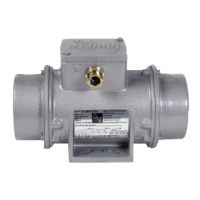Page 38
FAULT FINDING – VIBRATORS
1. Vibrator does not start or fails to run.
Provided that supply voltage is present at the vibrator terminal box check the following:
a) Supply voltage is correct and starter is operating correctly.
b) All three phases of supply voltage are connected and the brass links in the vibrator terminal box
are present and in correct position for supply voltage.
c) Vibrator is clear of “earth” faults and the stator winding is not open circuit in any one phase and
no short circuits exist between adjacent turns.
d) Vibrator is not overloaded electrically or mechanically (See 2).
2. Vibratory current exceeds rated full load current or overheats
Check:
a) That vibrator fixing bolts are correctly tightened and there is no damage to end covers
preventing weights rotating.
b) Bearings are not partially seized or over greased.
c) Out of balance weights are not set at too great force output, particularly on hopper applications.
3. Vibrator Noisy
NOTE Due to the increased radial clearance in the bearings it is normal for vibrators to emit a
certain amount of noise and they should not be compared with standard electric motors.
Check:
a) That there are no loose parts on the vibrator.
b) End covers are not damaged and fouling out of balance weights.
c) Noise is not due to bearing failure.
4. Vibrator(s) does(do) not attain synchronous speed
Check:
a) That the vibrator is not wrongly connected (star instead of delta)
b) Supply voltage and supply frequency are not too low.
c) Vibrator is not overloaded or partially seized.

